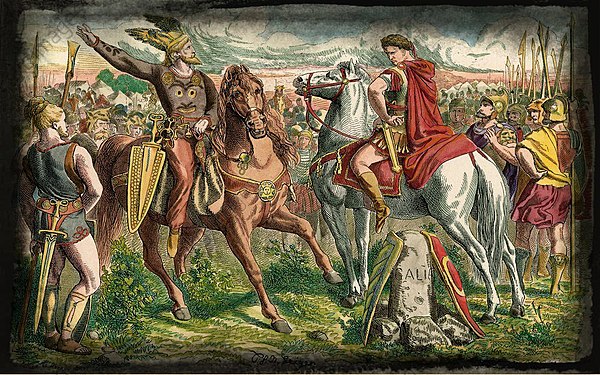After the Belgae gave up on their siege of the town of Bibrax, belonging to the Remi tribe, they encamped their army within two Roman miles of Caesar's camp. Although he was reluctant to give battle at first, some minor cavalry skirmishes between the camps gave Caesar the impression that his men were not inferior to the Belgae, and thus decided on a pitched battle.
As Caesar's forces were outnumbered and thus at risk of being out-flanked, he had his army build two trenches, each 400 paces long, one on each side of the plain before the Roman camp. At the end of these trenches, Caesar had small forts built in which he placed his artillery. Then, leaving two legions as a reserve in the camp, he drew up his remaining six in battle order, and the enemy did the same. The crux of the battle lay in the small marsh that was situated between the two armies, and both forces anxiously anticipated the other's crossing of this obstacle, as it was sure to disorder the forces that did so. Cavalry skirmishes began the battle, although neither force crossed the marsh. Caesar claims his forces came out favourably in these initial actions, and so led his forces back to his camp.
After Caesar's manoeuver the Belgic forces circumvented the camp and endeavoured to approach it from behind. The rear of the camp was bordered by the river Axona (today called the River Aisne), and the Belgae sought to attack the camp via a single fording spot in the river. Caesar claims their intention was to lead a part of their force over the bridge, and either take the camp by storm, or cut the Romans off from the lands on the opposite side of the river. This tactic would both deprive the Romans of land for foraging, and prevent them from coming to the aid of the Remi tribe whose lands the Belgae had the intention of pillaging (as mentioned in the Prelude, above). To counter this manoeuver, Caesar sent all his light infantry and cavalry to manage the difficult terrain (as it would have been more difficult for the heavy infantry to do so).
Dismayed by the courageous attack by Caesar's men, and by their consequent inability to either take the camp by storm or blockade the Romans from crossing the river, the Belgic forces withdrew to their camp. Then, calling a council of war, they immediately resigned to returning to their home territories, where they might better be able to engage Caesar's invading army.
So rushed and unorganized was the Belgic departure from their camp, that it seemed very much like a panicked retreat to the Roman forces. However, as Caesar was as yet unaware of their reason for departing, he decided not to immediately pursue the forces, for fear of an ambush. The following day, after learning from his scouts of the fully-fledged retreat of the Belgic forces, Caesar sent three legions and all his cavalry to attack the rear of the Belgic marching column. In his account of this action, Caesar claims that these Roman forces killed as many men as the daylight allowed, without any risk to themselves (as the Belgic forces were taken by surprise and breaking rank, sought safety in flight).










































